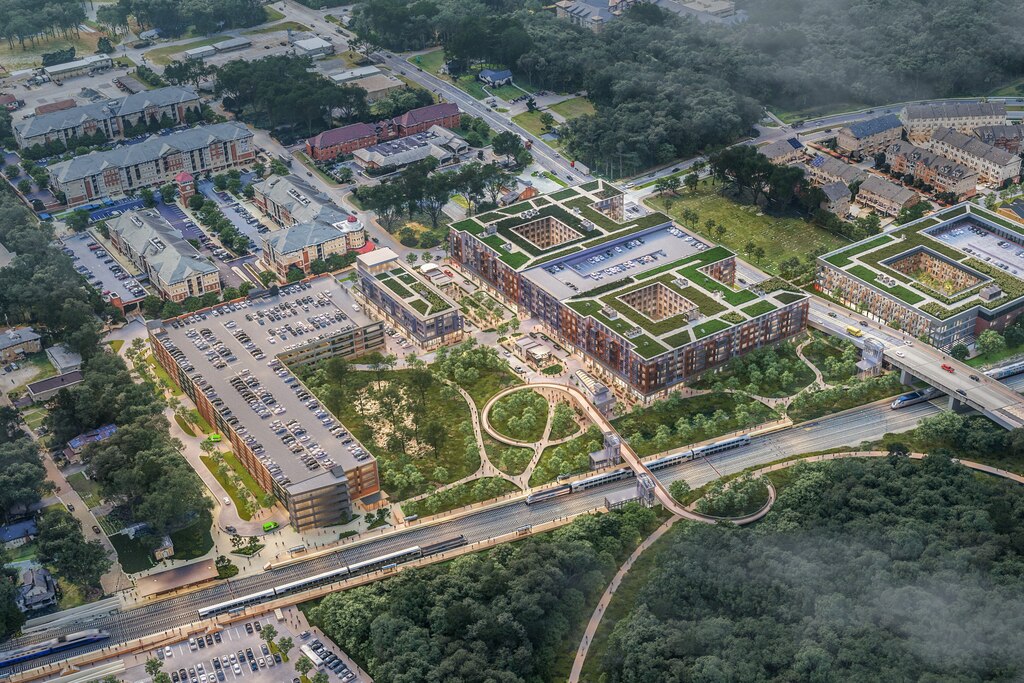Driving a car to the parking lot to catch the MARC train is so 1984. Get with the times, people — wouldn’t it be nice to live within walking distance of the station instead?
Few people can walk to a MARC station now. But that could change in a few years under a new state transportation plan released Thursday. The Maryland Department of Transportation wants to encourage construction of apartments and other housing — an estimated 2,600 total units — next to six train stations between Baltimore’s Penn Station and Washington, D.C.’s Union Station.
The strategic transit-oriented development, or TOD, plan includes “market insight and recommendations for the development of 170 acres of undeveloped State-owned land around Penn Line stations,” according to a transportation department press release. The 73-page document lays out challenges and opportunities for each of the six stations and includes conceptual designs for what could be built at each.
“We’re at the foundation stage, laying it, laying the strategy,” said Joe McAndrew, assistant secretary for project development and delivery with the state transportation department.
In other parts of the country, dense housing development next to reliable trains has created symbiotic relationships that allow both to thrive. Major mixed-use developments have often followed the opening of new stations along Washington’s Metro subway system. But next to MARC, light rail and Baltimore’s Metro stations, the state mostly just built parking lots. The state is now looking to catch up as it combats a housing shortage estimated at more than 90,000 units while simultaneously getting more cars off the roadway.
A law that passed in Annapolis this year aims to help with that. It allows for greater housing density than what zoning regulations typically allow if a lot is within a half-mile of a train station — it is meant to encourage construction of apartments, townhomes, grocery and retail stores and more on land dominated by parking lots and empty space.
In the months since, state transportation officials have started laying out visions for stations along the Baltimore region’s Metro and light rail stations. Now, MARC’s Penn Line, the most popular of the commuter rail network that moves about 350,000 people every month, is joining the fold.
Penn Line ridership is still only about half of what it was for a typical weekday compared to before the pandemic, McAndrew said, but weekend trips are back to pre-pandemic levels. The TOD plan does not apply to stations along both the MARC Camden and Brunswick Lines. The Maryland Transit Administration pays CSX Transportation a monthly access fee to operate the two lines on their tracks.
“It provides a road map for how we do meaningful TOD around these sites, and it’s mainly focused on joint development,” said David Zaidain, chief of real estate and transit-oriented development for the state transportation department.
McAndrew and Zaidain acknowledged that not all communities are “ready” for this kind of development.
Though TOD has been successful at nearby Owings Mills, a small group of residents opposed construction of apartments next to the Lutherville light rail station. Officials have called the site, which is within walking distance of grocery stores, a doctor’s office, a church, tons of restaurants and more, a perfect area for denser housing. The massive parking lot and abandoned shopping center were recently zoned for single-family homes.
For now, state officials will focus their energy on areas where they have local partners, McAndrew said. He lauded both Anne Arundel County Executive Steuart Pittman and leaders at Bowie State University, a historically Black university in Prince George’s County, for their willingness to see the Penn Line vision.
That partnership helped to make two MARC stations in particular — Odenton and Bowie State — priority stations in the new plan. It shows them as having the highest potential for return on public investment.

At Odenton, the state owns about 20 acres, most of which is now parking, where it says it could build more 900 residential units. The state could “build on the momentum of the Odenton Town Center developments that have been happening,” Zaidain said. There’s roughly six acres near the Bowie State station, where the state envisions more than 400 new residential units next to the growing university.

But the inclusion — or seeming lack thereof — of the West Baltimore MARC station in the vision is a bit of a head scratcher. For the five other stations, the plan presents gross tax revenue in the area and projects future gains like potential MARC ridership, residential units and financial feasibility. For West Baltimore, each of these boxes got an “N/A.”
The buzzword soup essentially says there’s too much ongoing planning in the area to develop a specific vision for the station area right now. Considerations include the planned east-west Red Line, Amtrak’s Frederick Douglass Tunnel and efforts to transform the “Highway to Nowhere.”
After a “long history of urban renewal and disinvestment,” as the TOD conceptual plan states, the area around the West Baltimore MARC station could look very different 10 years from now. The station itself is poised for a facelift as part of Amtrak’s new tunnel project.
But community groups in the area have been clamoring for new transit-oriented development around the station for years as a way to start turning the tide of that historic disinvestment sooner. Now some are wondering if it will ever come.



Comments
Welcome to The Banner's subscriber-only commenting community. Please review our community guidelines.